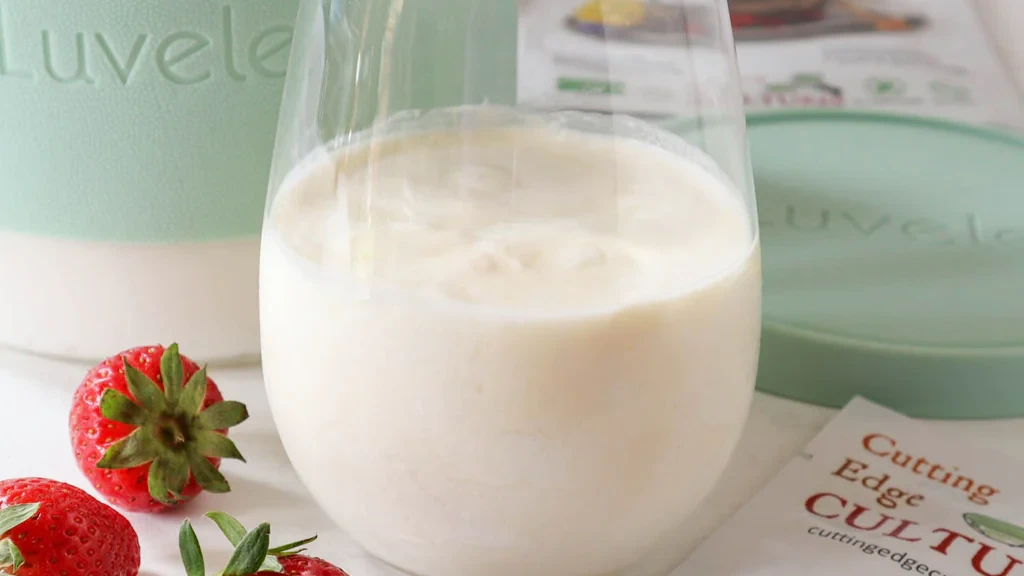Your Cart is Empty

Easy milk kefir made in a yogurt maker
Barb Hodgens
Barb Hodgens loves to cook with alternative, healthy whole food ingredients, with a focus on gut health. Barb has overcome her own gut health issues through healthy eating. Share your ideas, comments and photos at the end of this post :)

Foolproof Kefir!
Kefir is a fermented milk drink that has been around since the beginning of recorded history. It has exceptional health and curative properties and is packed with gut-supporting bacteria and yeasts. The process of making kefir is unique in its simplicity. Traditional kefir uses kefir ‘grains’ to culture milk. The grains are symbiotic living organisms, that contain lactic acid-producing bacteria and yeast. These microbes multiply and ferment the sugars in milk, and as long as they’re kept in fresh milk at the right temperature, they will stay reproducible indefinitely. For some people the process of keeping kefir grains alive is a responsibility.

Easy Kefir
Cutting Edge Cultures have created Easy Kefir, a freeze-dried kefir powder, that looks and behaves the same as yogurt starter culture. Easy Kefir contains all the strains and yeasts present in grains, and delivers all the benefits, but doesn’t form grains at any stage during fermentation. For those of you who are busy and worried about taking care of kefir grains, Easy Kefir is for you!
With Easy Kefir & a yogurt maker it’s the easiest method you can imagine.
Kefir is ideally fermented for 24-hours at around 25°C/78°F. (room temperature) and is traditionally made without any special equipment other than a sterile glass jar left on your bench top. Incubation time is a little unpredictable. Fermentation is faster in warm weather and can have a strong, sour flavour. In cool temperatures it can take several days and result in a weak fermentation. The benefits of making Kefir in a yogurt maker are plentiful. The new Luvele Yogurt Makers control the consistency of your Kefir whatever the weather. With Easy Kefir and a yogurt maker, making your own kefir can take as little as a few minutes per batch, and you’re guaranteed it will come out thick, creamy, mild, and delicious every batch.
Take care, most yogurt makers are designed to maintain a temperature close to 40°C/104°F, which will kill Kefir. The new model Pure Yogurt Maker has a broad temperature range (25°C- 50°C / 78°F - 122°F.) that can now incubate kefir and fermented foods other than yogurt.
Please note that even though Easy Kefir does not produce actual kefir grains, you can take a portion of your kefir, add it to more milk, and reculture it over and over.

Taste
Homemade kefir has a tangy, slightly fizzy, sour taste and looks similar to thin yogurt. The first batch tends to be mild tasting, it will get stronger in subsequent batches. Expect it to taste quite different but better than store-bought kefir.
What’s the difference between yogurt and kefir?
Yogurt and kefir have many similarities, but kefir is more potent and tends to have a higher probiotic count and more diversity of bacterial strains and yeasts. Most yogurts have 3 - 7 probiotic strains of good bacteria. Kefir contains 30 - 50 major strains of friendly bacteria not commonly found in yogurt. It has been said that antibiotics cannot kill certain strains of bacteria in kefir. Easy kefir contains over 3 billion live bacteria and over 50,000 lactic yeasts per gram. These probiotic yeasts put the fizz in kefir and dominate, kill, and control pathogens in the gut.
Kefir is also far easier to make. Simply use cold milk straight from the fridge. No heating and holding the milk at a certain temperature required. It’s that easy!
What milk do I use to make kefir?
Full cream (whole milk) or half and half with a higher fat content will result in a rich, creamy kefir. Other milks are suitable, but the consistency may be variable. Goat milk or raw milk will produce thin, drinking kefir.
Keep in mind that even if you’re lactose-intolerant, you can probably enjoy homemade milk kefir without any discomfort, because the beneficial bacteria break lactose down into harmless lactic acid.
How to thicken Kefir.
If your kefir turns out thin or has separated into whey and curds, you can strain it to achieve the perfect texture. Straining removes excess liquid and concentrates the milk solids, resulting in thicker kefir. To strain kefir, simply pour it through a cheesecloth-lined strainer, paper coffee filter or nut milk bag over a bowl and let it drain for a few hours. The longer you strain the kefir, the thicker it will become. Save the whey that has dripped into the bowl and place it in a glass jar in the fridge. See here for the many uses for whey.




Easy milk kefir made in a yogurt maker
Luvele
Rated 5.0 stars by 1 users
Kefir is a fermented milk drink that has been around since the beginning of recorded history. It has exceptional health and curative properties and is packed with gut-supporting bacteria and yeasts.The process of making kefir is unique in its simplicity. Traditional kefir uses kefir ‘grains’ to culture milk. The grains are symbiotic living organisms, that contain lactic acid-producing bacteria and yeast.
Ingredients
- 2 litre (2.1 qt) of full cream milk (whole or half and half)
- 1 packet of Easy Kefir
Directions
- Thoroughly rinse your yogurt making glass jar and whisk with boiling water.
Pour the milk into the yogurt making glass jar.
Pour the Easy Kefir starter into the milk and stir thoroughly with a whisk to incorporate.
- Place the lid firmly on the glass yogurt jar and place into your yogurt maker. Pour water slowly into the base. (The water must not be filled over the ‘tall line’ indicated on the inside wall of the maker). Then place the cover lid on top.
Use the digital control panel to set the temperature to 25°C/78°F and the time to 24-hours, then press ‘confirm’ to begin incubation.
At the end of the fermentation, turn the yogurt maker off. Remove the cover lid and gently lift out the glass jar. Straight from the yogurt maker, the kefir will be warm. Place the jar in the fridge for at least 6 hours or overnight to set.
When you put the kefir in the fridge the fermentation process continues but chilling it will slow down the fermentation of the healthy bacteria and beneficial yeast.
RECULTURINGOnce you’ve made your first batch of kefir, you can use some of it to make more kefir, so don’t drink all of it! Simply reserve half a cup of this kefir, add it to fresh milk, then incubate in the yogurt maker again. You can do this up to seven times or perhaps more. When your batch is too sour, or doesn't thicken as before, it's time to start over with an Easy Kefir packet.
Recipe Video
PIN THIS RECIPE

Easy milk kefir made in a yogurt maker

Foolproof Kefir!
Kefir is a fermented milk drink that has been around since the beginning of recorded history. It has exceptional health and curative properties and is packed with gut-supporting bacteria and yeasts. The process of making kefir is unique in its simplicity. Traditional kefir uses kefir ‘grains’ to culture milk. The grains are symbiotic living organisms, that contain lactic acid-producing bacteria and yeast. These microbes multiply and ferment the sugars in milk, and as long as they’re kept in fresh milk at the right temperature, they will stay reproducible indefinitely. For some people the process of keeping kefir grains alive is a responsibility.

Easy Kefir
Cutting Edge Cultures have created Easy Kefir, a freeze-dried kefir powder, that looks and behaves the same as yogurt starter culture. Easy Kefir contains all the strains and yeasts present in grains, and delivers all the benefits, but doesn’t form grains at any stage during fermentation. For those of you who are busy and worried about taking care of kefir grains, Easy Kefir is for you!
With Easy Kefir & a yogurt maker it’s the easiest method you can imagine.
Kefir is ideally fermented for 24-hours at around 25°C/78°F. (room temperature) and is traditionally made without any special equipment other than a sterile glass jar left on your bench top. Incubation time is a little unpredictable. Fermentation is faster in warm weather and can have a strong, sour flavour. In cool temperatures it can take several days and result in a weak fermentation. The benefits of making Kefir in a yogurt maker are plentiful. The new Luvele Yogurt Makers control the consistency of your Kefir whatever the weather. With Easy Kefir and a yogurt maker, making your own kefir can take as little as a few minutes per batch, and you’re guaranteed it will come out thick, creamy, mild, and delicious every batch.
Take care, most yogurt makers are designed to maintain a temperature close to 40°C/104°F, which will kill Kefir. The new model Pure Yogurt Maker has a broad temperature range (25°C- 50°C / 78°F - 122°F.) that can now incubate kefir and fermented foods other than yogurt.
Please note that even though Easy Kefir does not produce actual kefir grains, you can take a portion of your kefir, add it to more milk, and reculture it over and over.

Taste
Homemade kefir has a tangy, slightly fizzy, sour taste and looks similar to thin yogurt. The first batch tends to be mild tasting, it will get stronger in subsequent batches. Expect it to taste quite different but better than store-bought kefir.
What’s the difference between yogurt and kefir?
Yogurt and kefir have many similarities, but kefir is more potent and tends to have a higher probiotic count and more diversity of bacterial strains and yeasts. Most yogurts have 3 - 7 probiotic strains of good bacteria. Kefir contains 30 - 50 major strains of friendly bacteria not commonly found in yogurt. It has been said that antibiotics cannot kill certain strains of bacteria in kefir. Easy kefir contains over 3 billion live bacteria and over 50,000 lactic yeasts per gram. These probiotic yeasts put the fizz in kefir and dominate, kill, and control pathogens in the gut.
Kefir is also far easier to make. Simply use cold milk straight from the fridge. No heating and holding the milk at a certain temperature required. It’s that easy!
What milk do I use to make kefir?
Full cream (whole milk) or half and half with a higher fat content will result in a rich, creamy kefir. Other milks are suitable, but the consistency may be variable. Goat milk or raw milk will produce thin, drinking kefir.
Keep in mind that even if you’re lactose-intolerant, you can probably enjoy homemade milk kefir without any discomfort, because the beneficial bacteria break lactose down into harmless lactic acid.
How to thicken Kefir.
If your kefir turns out thin or has separated into whey and curds, you can strain it to achieve the perfect texture. Straining removes excess liquid and concentrates the milk solids, resulting in thicker kefir. To strain kefir, simply pour it through a cheesecloth-lined strainer, paper coffee filter or nut milk bag over a bowl and let it drain for a few hours. The longer you strain the kefir, the thicker it will become. Save the whey that has dripped into the bowl and place it in a glass jar in the fridge. See here for the many uses for whey.



PIN THIS RECIPE

SUBSCRIBE
Sign up to get weekly healthy recipes & information on new product releases.
